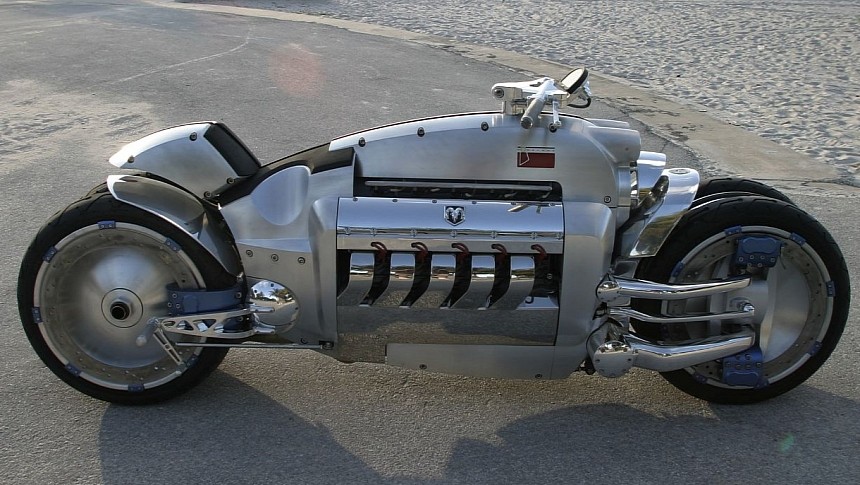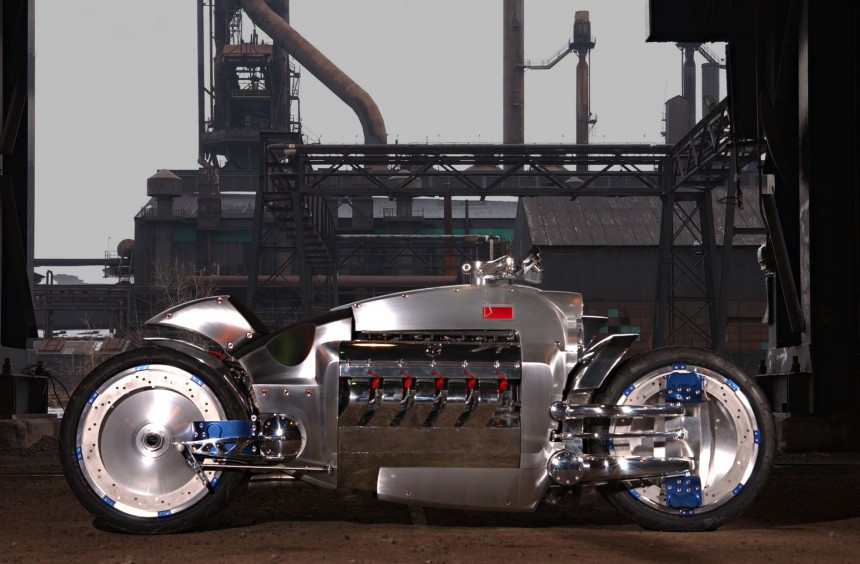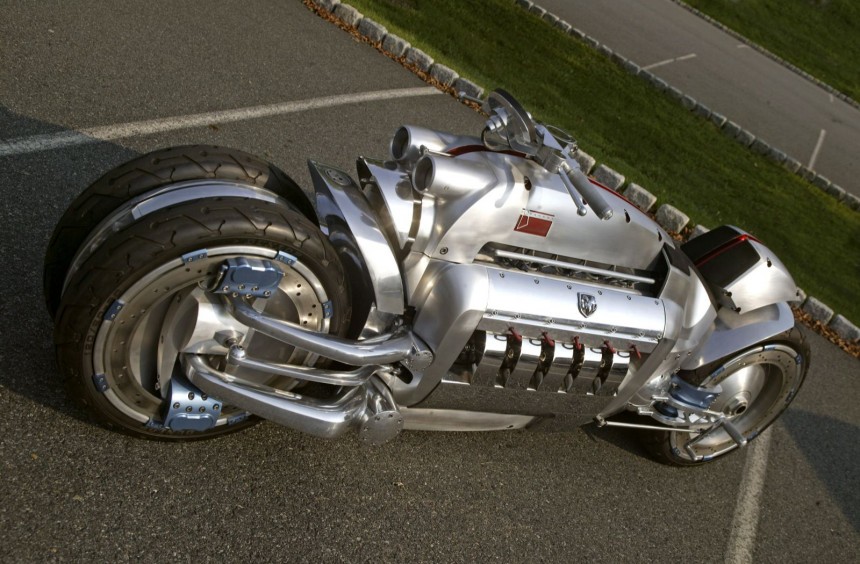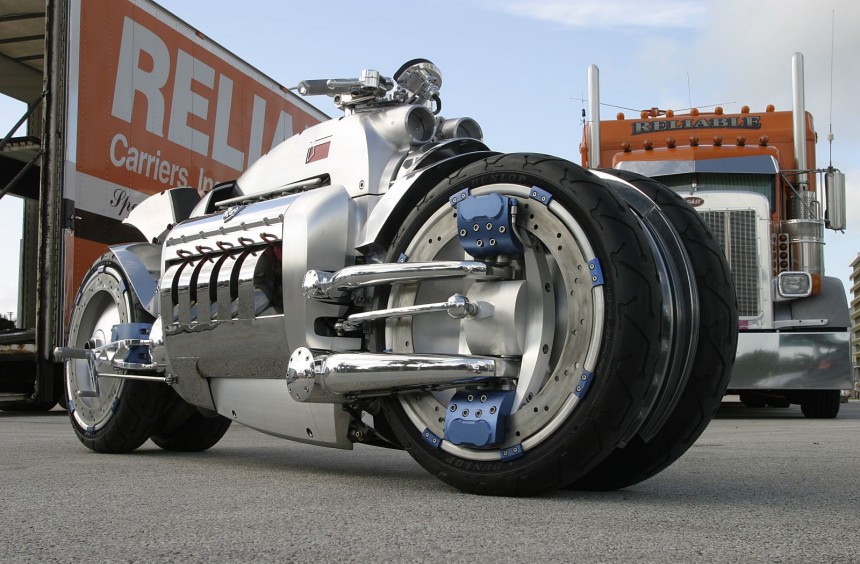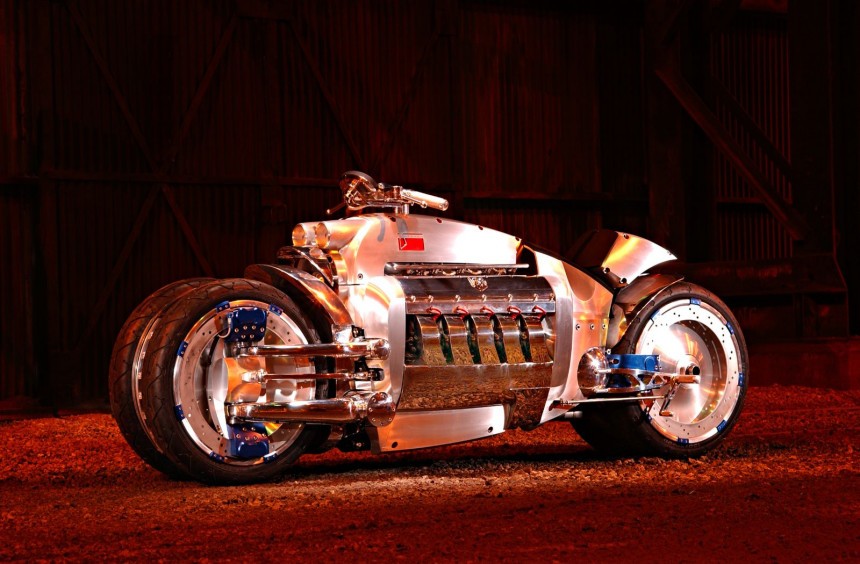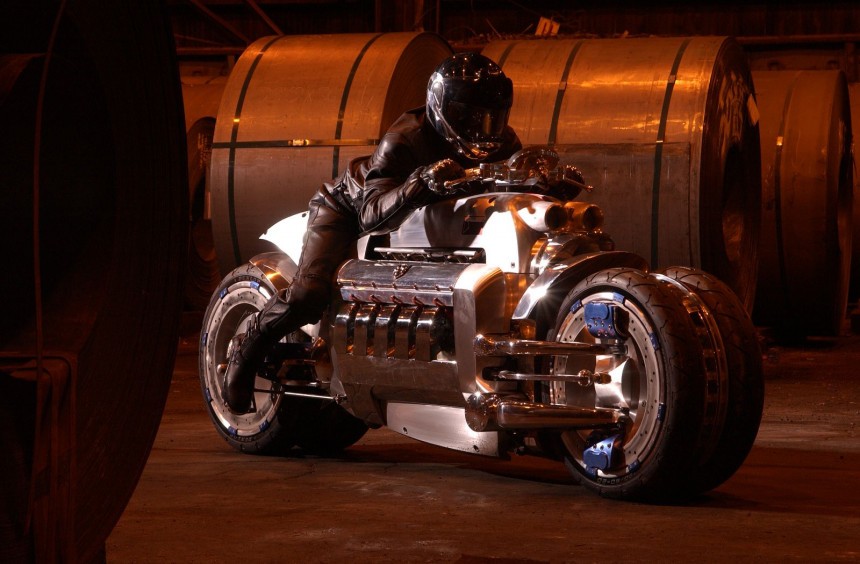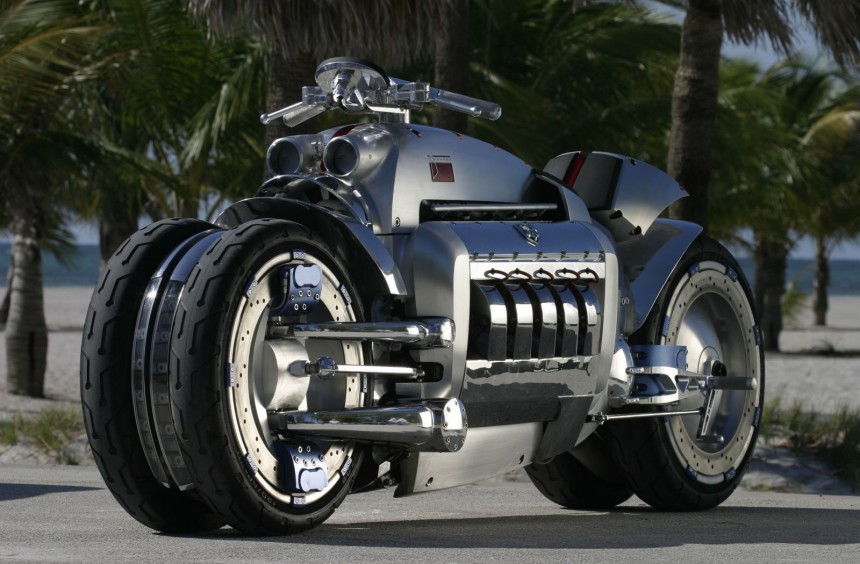Though it looked like a prop taken from a Sci-Fi movie set, the Tomahawk was very much real. With four wheels, an independent suspension system, and a huge V10 borrowed from the Viper, it remains one of the most insane vehicles ever built.
The Chrysler Corporation (now part of the Stellantis group) has a long history of producing showstopping concept cars. It all started in 1940 with the innovative Thunderbolt and continued with even more impressive vehicles like the 1954 Plymouth Belmont, the 1989 Dodge Intrepid, or the 1995 Chrysler Atlantic.
Those concept cars were extremely successful, helping the corporation's brands showcase innovative technologies and daring styling cues that trickled down to their production models.
However, in the early-2000s, a couple of employees came up with an idea that took the notion of a concept to a whole new level of outrageousness.
The story of the Tomahawk starts with design office modeler Bob Schroeder and vehicle build specialist Dave Chyz. The two Chrysler employees were having a conversation about the ultimate enthusiast's vehicle. Bob, a motorcycle rider, thought it should be a crazy Boss Hoss-type bike, while Dave, an amateur drag racer, suggested that such a vehicle should definitely have a Viper V10.
In one of those "hold my beer" moments, the two colleagues took their idea to Senior Vice President of Design Trevor Creed, who initially laughed off their proposal, adding that the corporation doesn't build bikes.
Nevertheless, Bob and Dave didn't give up on their insane idea. With the help of some like-minded colleagues, they made a series of sketches and returned to Creed's office. The VP was blown away by what he saw, and this time, he promised to take the proposal up the corporate ladder to DaimlerChrysler VP of advanced design Freeman Thomas.
In an unlikely turn of events, Thomas commissioned a full presentation that could be shown, submitted for approval to the corporation's top brass, and assigned stylist Mark Walters to head the project.
At Thomas' suggestion, the theoretical Franken-bike received two wheels in the front and rear, inspired by the vehicles in the Sci-Fi movie Tron.
By the spring of 2002, Walters and his team scheduled an ambitious presentation that featured multiple sketches spread across a 20-foot (6.1 m) wall and an actual Viper V10 resting on an engine stand with motorcycle wheels placed on both ends.
The presentation was attended by Chrysler Group COO Wolfgang Bernhard and CEO Dieter Zetsche, who, after lifting their jaws from the ground, approved the development of a fully-functional concept.
The design team immediately went to work, assigning fabrication duties to Kirt Bennett's RM Motorsports in Wixom, Michigan.
The custom frame designed around the Viper's mammoth engine was custom-built by RM from solid pieces of aluminum alloy.
The concept received a patented independent suspension system with front hub-center steering, loosely inspired by the 1983 Elf 3 Honda racing motorcycle.
At the front, the system featured a double horizontal fork and hub-center steering swingarms connected to the outer side of each wheel. At the rear, a similar setup was employed, albeit the swingarms were connected to the inner part of each wheel.
This design allowed the rider to countersteer and lean into turns, similar to a conventional tilting three-wheeler.
To accommodate a low-slung saddle that allowed the rider to comfortably place both feet on the ground when the vehicle was stopped, the 8.3-liter ZB I V10 sourced from the upcoming third-gen Viper received several modifications. These included a new dry-sump lubrication system, two smaller radiators fitted on top, and a belt-driven cooling fan borrowed from a Porsche 911.
After only six months of work, the outrageous concept dubbed Dodge Tomahawk was unveiled at the 2003 North American International Auto Show in Detroit.
Featuring many other breathtaking concepts like the Cadillac Sixteen, Ford 427, or GM's hydrogen-powered Hy-wire, the event drew its largest-ever crowd with a total of 810,699 attendees.
Although a jury of 35 journalists chose GM's Hy-wire for the 2003 Specialty Concept Vehicle of the Year award, the Tomahawk was the public's favorite concept - and it wasn't even close.
Initially, Dodge claimed that the 1,500-pound (680 kg), 500-hp concept was theoretically capable of accelerating from 0 to 60 mph (97 kph) in 2.5 seconds and reaching a top speed of 400 mph (643.7 kph).
However, those figures were mocked by the press, who argued that no one would be brave enough to try and back them up by conducting a real-life speed test. Without extensive wind protection and a secure riding position, even reaching 200 mph (320 kph) was deemed humanly impossible.
As it turned out, Dodge didn't allow any independent testing of the Tomahawk but continued to float those outrageous figures around on multiple occasions.
The fact that the Tomahawk made it from an insane idea to a fully-functional concept was, in more ways than one, a miracle. Dodge called it a "ridable automotive sculpture" intended only to showcase what can be done if you let engineers and designers loose.
Despite that, a surprisingly large number of wealthy enthusiasts pushed for a production run, but Dodge repeatedly dismissed such inquiries.
Nevertheless, American luxury retailer Neiman Marcus obtained the rights to produce nine so-called replicas of the Tomahawk. Built by RM Motorsports to the exact specs of the concept, these non-street-legal units were sold for $555,000 ($555,000 today) each.
Twenty years after its public debut, the Dodge Tomahawk remains an unparalleled exercise of design and engineering madness. Though many still debate its actual performance figures and its motorcycle status, there's no question it's one of the craziest vehicles ever created.
If you want to learn more about the Tomahawk's story, we recommend the YouTube video below by Marspeed.
Those concept cars were extremely successful, helping the corporation's brands showcase innovative technologies and daring styling cues that trickled down to their production models.
However, in the early-2000s, a couple of employees came up with an idea that took the notion of a concept to a whole new level of outrageousness.
How it all began
In one of those "hold my beer" moments, the two colleagues took their idea to Senior Vice President of Design Trevor Creed, who initially laughed off their proposal, adding that the corporation doesn't build bikes.
Nevertheless, Bob and Dave didn't give up on their insane idea. With the help of some like-minded colleagues, they made a series of sketches and returned to Creed's office. The VP was blown away by what he saw, and this time, he promised to take the proposal up the corporate ladder to DaimlerChrysler VP of advanced design Freeman Thomas.
In an unlikely turn of events, Thomas commissioned a full presentation that could be shown, submitted for approval to the corporation's top brass, and assigned stylist Mark Walters to head the project.
Turning an insane idea into reality
By the spring of 2002, Walters and his team scheduled an ambitious presentation that featured multiple sketches spread across a 20-foot (6.1 m) wall and an actual Viper V10 resting on an engine stand with motorcycle wheels placed on both ends.
The presentation was attended by Chrysler Group COO Wolfgang Bernhard and CEO Dieter Zetsche, who, after lifting their jaws from the ground, approved the development of a fully-functional concept.
The design team immediately went to work, assigning fabrication duties to Kirt Bennett's RM Motorsports in Wixom, Michigan.
An engineering masterclass
The concept received a patented independent suspension system with front hub-center steering, loosely inspired by the 1983 Elf 3 Honda racing motorcycle.
At the front, the system featured a double horizontal fork and hub-center steering swingarms connected to the outer side of each wheel. At the rear, a similar setup was employed, albeit the swingarms were connected to the inner part of each wheel.
This design allowed the rider to countersteer and lean into turns, similar to a conventional tilting three-wheeler.
To accommodate a low-slung saddle that allowed the rider to comfortably place both feet on the ground when the vehicle was stopped, the 8.3-liter ZB I V10 sourced from the upcoming third-gen Viper received several modifications. These included a new dry-sump lubrication system, two smaller radiators fitted on top, and a belt-driven cooling fan borrowed from a Porsche 911.
A triumphant debut
Featuring many other breathtaking concepts like the Cadillac Sixteen, Ford 427, or GM's hydrogen-powered Hy-wire, the event drew its largest-ever crowd with a total of 810,699 attendees.
Although a jury of 35 journalists chose GM's Hy-wire for the 2003 Specialty Concept Vehicle of the Year award, the Tomahawk was the public's favorite concept - and it wasn't even close.
Outrageous performance claims
However, those figures were mocked by the press, who argued that no one would be brave enough to try and back them up by conducting a real-life speed test. Without extensive wind protection and a secure riding position, even reaching 200 mph (320 kph) was deemed humanly impossible.
As it turned out, Dodge didn't allow any independent testing of the Tomahawk but continued to float those outrageous figures around on multiple occasions.
A limited production run
Despite that, a surprisingly large number of wealthy enthusiasts pushed for a production run, but Dodge repeatedly dismissed such inquiries.
Nevertheless, American luxury retailer Neiman Marcus obtained the rights to produce nine so-called replicas of the Tomahawk. Built by RM Motorsports to the exact specs of the concept, these non-street-legal units were sold for $555,000 ($555,000 today) each.
Twenty years after its public debut, the Dodge Tomahawk remains an unparalleled exercise of design and engineering madness. Though many still debate its actual performance figures and its motorcycle status, there's no question it's one of the craziest vehicles ever created.
If you want to learn more about the Tomahawk's story, we recommend the YouTube video below by Marspeed.
